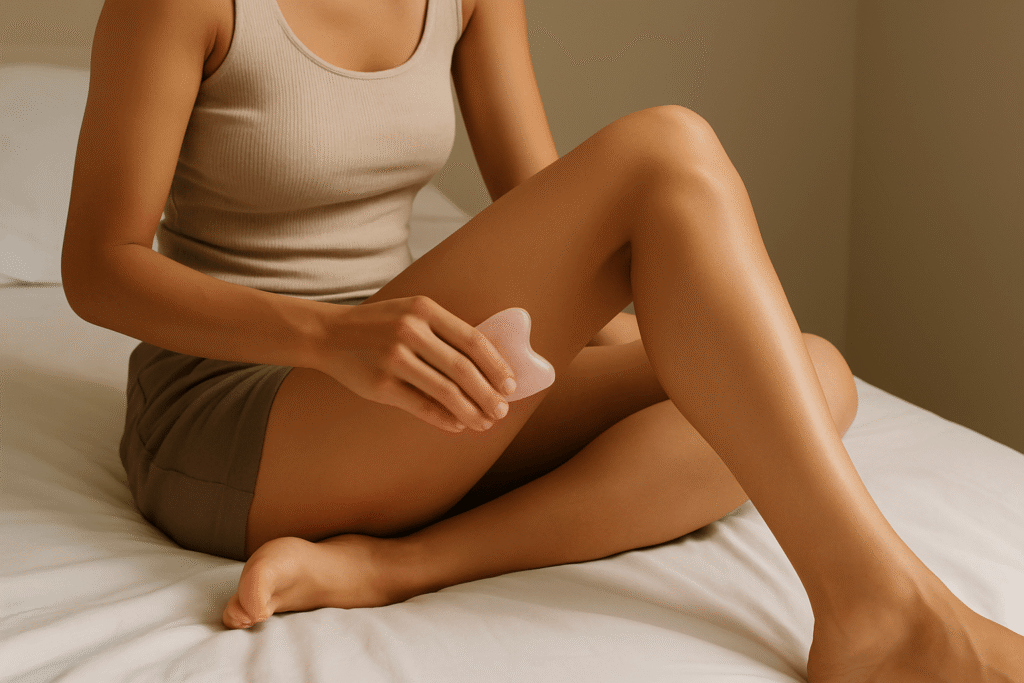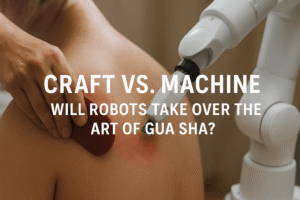
With people’s increasing focus on health and wellness, Gua Sha, an ancient Eastern physical therapy, has regained widespread attention recently. Gua Sha for legs is a key component of this practice. Users report that it improves blood circulation in the legs, thereby relieving muscle soreness and improving overall well-being.
Today, we’ll take a detailed look at Gua Sha for legs and explain its true nature.
Key Benefits of Gua Sha for Legs
As an old Chinese saying goes, “A person’s legs age first.” This means that the legs are the first part of a person to show signs of aging, and this is indeed true. If you observe the elderly, you’ll notice a pattern: while most may still be mentally alert and able to carry considerable weight, their leg flexibility and stability are significantly reduced compared to younger people. Because the legs support the entire body’s weight, age-related deterioration of leg muscles is bound to severely impact them.
The legs, subjected to long-term stress, often impair Qi and blood circulation and meridians, and are prone to muscle strain. Gua Sha can significantly improve these symptoms. Leg Gua Sha offers the following benefits:
- Promotes blood circulation and lymphatic detoxification.
- Relieves muscle soreness and repairs sports injuries.
- Eliminates leg edema and cellulite.
- Promotes metabolism and skin health.
- Helps relieve varicose veins and discomfort.。
It should be noted that different people have different causes of illness and different constitutions, even though the symptoms may be similar. Therefore, the same gua sha method may have different effects on different people. Please adjust according to your actual situation.
The Principle of Guasha for Legs
Gua Sha involves rubbing a smooth gua sha tool across the skin’s surface while applying pressure to the muscles to relax them. This gua sha technique can:
- Dilate capillaries, improve the flow of Qi and blood, and increase local blood flow.
- Promote detoxification of the lymphatic system, helping to remove harmful substances and reduce swelling.
- The superficial damage to the skin’s surface may stimulate the body’s natural healing function, promoting soft tissue repair.
According to Traditional Chinese Medicine (TCM) theory, literature, and various clinical data, leg gua sha helps dredge meridians and harmonize Qi and blood. Furthermore, TCM considers the legs to be an essential component of maintaining human health, closely connected to the internal organs and meridians, as evidenced by the acupuncture points on the feet. TCM believes that acupuncture points corresponding to the five internal organs are distributed on the soles of the feet, and specialized massage of these areas can improve their function.
Sources:
- People’s Daily Health Channel: A Study on the Effectiveness of Gua Sha [1]
- Chinese Journal of Traditional Chinese Medicine [2]
- Journal of Pain: A Study on Gua Sha for Relieving Muscle Pain.
How to Use Gua Sha for Legs?
Gua Sha can bring many benefits, but it needs to be based on correct use. In fact, Gua Sha is not difficult. You can refer to the following:
1. Make good preparations
- Choose a suitable and safe gua sha tool. We recommend using a tool made of natural jade crystal or stainless steel for increased safety. Given the high muscle mass in the leg area, choose a larger tool for optimal results.
- Lubricate the tool before gua sha. Choose a lubricant suitable for your skin type. This will reduce friction and alleviate any redness or swelling after gua sha.
- Disinfect the tool thoroughly. Disinfect the tool with alcohol, both before and after gua sha.
- Select a warm, quiet environment for gua sha (optional).
2. Correct Gua Sha Method
- Scrape from the bottom up, following the muscle lines.
- Focus on the back of the thigh and calf muscles, applying greater pressure.
- Repeat 10-15 times for each area. Avoid excessive movements.
- Avoid areas with prominent joints and bones, such as the front of the calf, ankles, and knees. Also avoid areas with open wounds or bruises.
- Each scraping session should last no more than half an hour, and the frequency should be limited to no more than three times a week. Considering each individual’s individual situation, adjustments should be made based on individual circumstances.
Following the above-mentioned gua sha method, you can experience the basic therapeutic effects of scraping. However, considering the professionalism, if you want to get the best leg gua sha effect, it is recommended that you go to a professional gua sha institution to experience it.
3. Precautions for Gua Sha for Legs
- If you have skin wounds, infections, eczema, or severe varicose veins, you should avoid using gua sha or seek professional advice.
- We do not recommend using Gua Sha for pregnant women or those with blood disorders. If necessary, consult a professional doctor and perform the procedure under professional guidance.
- If persistent pain or unusual redness or swelling occurs, discontinue the procedure and consult a professional.
- Avoid rinsing with cold water after Gua Sha; keep the area warm. Avoid getting sick from viruses or harmful substances.
Although gua sha is highly safe, it is not completely foolproof. Be fully prepared to minimize risks and maximize benefits.
Conclusion
Gua Sha, a relatively safe and convenient traditional Chinese medicine treatment, has become a popular way to relieve leg fatigue, improve recovery from sports injuries, and enhance overall health. However, given individual differences, be prepared for unexpected results and seek professional help if necessary.
If you’re interested in incorporating Gua Sha into your daily wellness routine, try it on your legs and experience the natural relief and boost in vitality it brings.
In addition, you can also incorporate foot massage and scraping into the overall leg massage treatment to achieve more comprehensive and significant results.






